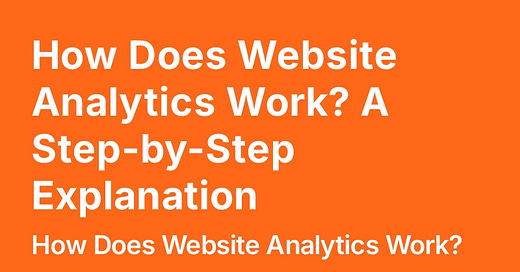Website analytics is essential for understanding how visitors interact with your site. Whether you are looking to improve traffic, boost engagement, or enhance conversions, monitoring website analytics effectively gives you insights to make informed decisions. In this guide, we’ll break down how website analytics works step-by-step. If you’re looking for a GA4 alternative or just starting with website analytics, this article will give you the basics.
1. What Is Website Analytics?
Website analytics involves collecting, measuring, and analyzing data from your website to understand user behavior and track performance. It details where your visitors come from, what they do on your site, and how often they return. By understanding this data, you can adjust your website to better meet user needs and achieve your business goals.
2. How Website Analytics Works: Step-by-Step
Let’s break down the critical steps to understanding how website analytics works.
Step 1: Data Collection
This information is recorded every time a visitor interacts with your website—by clicking, scrolling, or even just loading a page. Website analytics tools use tracking codes (like a JavaScript snippet) to collect data on these interactions. Tools like Google Analytics or a GA4 alternative gather this information automatically, helping you monitor website analytics effectively.
Step 2: Data Processing
Once collected, the data undergoes processing. During this step, your analytics tool organizes and cleans the raw data, filtering out irrelevant or duplicate information. For example, if a user refreshes a page multiple times, the tool may count only as one visit.
Step 3: Data Analysis
Next, the processed data is ready for analysis. Here, you’ll look at metrics like:
Traffic Sources: Where are your visitors coming from? (e.g., search engines, social media, direct visits)
Bounce Rate: The percentage of users who leave your site after viewing only one page.
Session Duration: How long users stay on your site.
Conversion Rate: The percentage of visitors who complete a desired action, like signing up or purchasing.
Analyzing these metrics helps you understand visitor behavior and identify areas for improvement.
Step 4: Reporting
Most analytics tools have built-in reporting features. They can show you data in visual formats like charts or graphs, making it easier to interpret. For example, you can quickly see if your website traffic has increased or if visitors spend more time on your site than last month. Look for customizable reporting options if you’re using a GA4 alternative to tailor the reports to your needs.
Step 5: Actionable Insights
The final step is turning data into action. You can make changes to your website based on the insights you gain. For instance:
Consider improving your page load speed or content quality if your bounce rate is high.
If certain pages have high traffic but low conversions, optimize them for better engagement (e.g., by adding a clear call-to-action or simplifying navigation).
3. Why Is Website Analytics Important?
Website analytics gives you a clear view of your site's performance, helping you make data-driven decisions. By monitoring website analytics effectively, you can:
Understand Your Audience: See who visits your site, where they come from, and what they like.
Optimize Marketing Campaigns: Track which campaigns drive the most traffic and adjust accordingly.
Improve User Experience: Discover what’s working and what needs improvement, from design to content.
Increase Conversions: Identify conversion roadblocks and make data-backed changes to boost sales or sign-ups.
4. Choosing the Right Tool for Website Analytics
There are many tools available for website analytics. Google Analytics 4 (GA4) is a popular option, but some users prefer a GA4 alternative for simplicity or additional features. When choosing a tool, consider:
Ease of Use: Can you navigate the tool without advanced technical knowledge?
Customization: Does it allow you to set custom goals, filters, and reports?
Data Privacy: Look for a tool that respects user privacy and complies with GDPR or other data regulations.
Tools like Usermaven and other GA4 alternatives offer simplified dashboards and features designed for users who want a more accessible approach to analytics.
5. Getting Started with Website Analytics
Ready to dive into website analytics? Here’s a quick checklist to help you get started:
Set Up Your Analytics Tool: Install the tracking code on your website.
Define Your Goals: Decide what actions you want to track (e.g., purchases, downloads).
Monitor Regularly: Check your data consistently, like weekly or monthly, to keep track of trends.
Optimize Based on Data: Make changes to your website based on the insights you gather.
Starting with these basics will help you monitor website analytics effectively and create a website that meets user needs while achieving your business goals.
Conclusion
Understanding how website analytics works is essential for improving your online presence. By following these steps—data collection, processing, analysis, reporting, and action—you can turn raw data into insights that drive real results. If you're exploring options, consider using a GA4 alternative to find the tool that best suits your needs.
With website analytics, you have the power to make informed, data-driven decisions that help your website grow and succeed. Start monitoring today and see how these insights can elevate your digital strategy!



